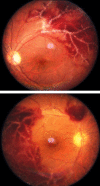Frosted branched angiitis due to viral meningo-encephalitis and ocular toxoplasmosis; a rare case report from Nepal
- PMID: 37427178
- PMCID: PMC10328650
- DOI: 10.1097/MS9.0000000000000905
Frosted branched angiitis due to viral meningo-encephalitis and ocular toxoplasmosis; a rare case report from Nepal
Abstract
Frosted branched angiitis (FBA) is characteristic florid translucent retinal perivascular sheathing of both arterioles and venules in association with variable uveitis and vasculitis affecting the entire retina. The vascular sheathing is supposed to be an immune-mediated reaction, possibly due to immune complex deposition in vessel walls secondary to various underlying etiologies. The authors aim to report a case of FBA secondary to herpes simplex virus and Toxoplasma gondii infection causing the diagnostic dilemma. This is the first case report on FBA from Nepal.
Case report: An 18-year-old young boy hospitalized with the diagnosis of acute viral meningo-encephalitis presented with the complaint of diminution of vision and floaters in both eyes for a week. Herpetic infection was confirmed with the cerebro-spinal fluid analysis and was under antiviral drugs. His presenting visual acuity was 20/80 in both eyes and ocular features were suggestive of FBA. The vitreous sample analysis revealed raised toxoplasma titre so intravitreal clindamycin was administered twice. The ocular features resolved in the subsequent follow ups with intravenous antiviral treatment and intravitreal antitoxoplasma treatment.
Conclusions: FBA is a very rare clinical syndrome secondary to many immunological or pathological causes. So, possible etiologies must be ruled out for timely management and good visual prognosis.
Keywords: frosted branched angiitis; herpex simplex; papillitis; phlebitis; toxoplasma gondii; vasculitis.
Copyright © 2023 The Author(s). Published by Wolters Kluwer Health, Inc.
Conflict of interest statement
The authors declare that there are no conflicts of interest regarding the publication of this article
Figures




References
-
- Díaz-Valle D, Díaz-Rodríguez E, Díaz-Valle T, et al. . Frosted branch angiitis and late peripheral retinochoroidal scar in a patient with acquired toxoplasmosis. Eur J Ophthalmol 2003;13:726–728. - PubMed
-
- Barkmeier AJ, Feman SS. Frosted branch angiitis secondary to herpes simplex virus infection progressing to acute retinal necrosis. Retin Cases Brief Rep 2009;3:36–37. - PubMed
-
- Ratra D, Jafferji S, Biswas J. Postsurgical bacterial endophthalmitis presenting as frosted branch angiitis: a case report. Retin Cases Brief Rep 2010;4:20–22. - PubMed
LinkOut - more resources
Full Text Sources
